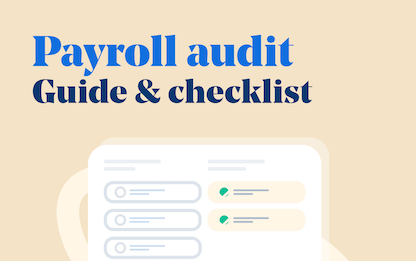- Blog
- |Managing Payroll
- >PAYE and Tax
- >payroll power hour recap
Payroll Power Hour: Four Questions Answered by our Payroll Experts


June marks our first-ever Payroll Power Hour.
A monthly webinar featuring our top payroll experts, these sessions are the perfect place to learn more about doing payroll.
From discussing the latest legislation to homing in on specific topics like payroll IDs and National Insurance, we’re here to answer all those burning payroll questions, like:
Which tax code should a particular employee be on if they live in Scotland?
How should you handle an underpayment?
Is your payroll ID the same as your HMRC ID (and should it be)?...
…and other questions or challenges that can trip you up when processing payroll.
Just think of it like your favourite teacher’s Office Hours, except…well, more Payroll-y.
Our first Power Hour took place on 20th June, and we kicked off with some great questions from our audience. If you missed it, here’s a quick recap of some of the questions we answered, including advice from two of our most knowledgeable payroll experts, Rebecca Russell and Iain Hunter-Moir.
As Rebecca points out, no question is ever too simplistic or silly to ask:

So without further ado, let’s dive into some of the questions we covered.
Payroll Power Hour: Four Questions Answered
How should you manage an employee on maternity leave who is planning to leave the business?
In this situation, Rebecca says there are two options to consider.
The first one is to process their Statutory Maternity Pay (SMP) as a payment after leaving. Using this method, you would treat them as if they were a leaver and do everything you would normally do, such as issue their P45 form. For this, you would use their actual leaving date and not the date the maternity leave ends. You would then base the pay they receive on that pay period.
The next step is to ‘re-activate’ them on your payroll system to process a payment after leaving. Rebecca adds that when it comes to the amount of SMP you’d pay, it would be the normal amount due for that pay period. In other words, you’d pay it for every pay cycle up until their maternity leave ends.
"You should not re-issue a P45", Rebecca continues, "instead, the employee is taxed on a non-cumulative 0T basis, so they're not using any of the freepay allowance already included on their P45." If they need proof of earnings, the alternative is to issue them a statement of earnings, though HMRC’s RTI system will ensure their taxable pay and tax paid is sent to their next employer.
The second option, though Rebecca personally doesn’t recommend this way, would be to pay a lump sum in their final pay period. However, as Rebecca warns, this could significantly impact National Insurance (except for company directors). But, in general, Rebecca advises that it’s best to avoid this option as it’s not cumulative and won’t be corrected later.
What is the process for changing HMRC IDs - and are these different from payroll IDs?
This is something, as Iain points out, that always gets flagged when new customers move to a new payroll software: “Many people get confused between what a payroll ID and RTI ID is - “and they are very different in terms of what they relate to.”
For some companies, the payroll number and HMRC RTI ID might be the same, but this is fairly rare. Usually, you’ll have two very different looking numbers for each employee, so it’s important to get clear on what these are:
Payroll ID - A simple set of numbers, normally linked to the employee, sometimes from a previous system such as an HRIS. Or it can simply be a number you give to an employee when they are hired.
HMRC RTI ID - The RTI ID, on the other hand, is usually a much longer string of numbers and letters. This number helps HMRC identify who is an employee within the RTI system and will be linked to any tax code changes, student loan notifications, etc.
In order to change an RTI ID, Iain says you’ll first need to identify the old RTI ID. The easiest option is to speak with your current payroll provider/software, otherwise HMRC can send you those IDs. The old ID and the new ID, plus an indicator notifying HMRC that the ID has changed, are sent to HMRC on your next FPS.
Some work will need to be done in the background to change this on your RTI file. There are a couple of columns - payroll ID change indicator and old payroll ID to change - that will need to be amended before the file is sent off. Once this is done, you’ll want to ensure both the old and new numbers are quoted on the RTI file before your next submission. Then HMRC will change the IDs according to what appears on the file.
What is the best way to work out an advance for an employee when a payment was missed in a previous month?
When working out any payment, Rebecca explains you first need to consider whether it’s for the same tax year. You need to answer the question, ‘will this payment be made in the same tax year, or are we now in a new year?’
If it’s different from the current year, then you’ll need to go back to this previous year in order to process the missing payment correctly. Rebecca further expands that you really should be paying the right amount of tax and National Insurance based on the tax year they should have been paid in. This is the most compliant way to do this.
In the case of it being last month, you should be able to make the adjustment in the following month without it having a negative impact on tax and National Insurance that the employee would pay. That is, as long as they’re on a cumulative standard tax code. To do that, you’ll need to go through the following steps:
1. 'First, look at the net pay on their payslip for the current month, after all of their payments (salary, overtime, bonus, commissions) and deductions
2. You'll then need to add in the missing payment, and check the employee's net pay again
3. Finally, you’ll need to work out the difference between the two, to know how much to advance to the employee.
The difference will be how much you can advance.
As per HMRC guidance, it’s better to make the adjustment in the current month, rather than going back and making the adjustment to the original month as this can cause discrepancies in HMRC’s system.
How should you handle underpayments and how can you avoid these going forward?
To start, Iain says, you’ll want to look at your internal processes to try and gain a better understanding of what might be going wrong: “Is it down to a disconnect in your workflows, or poor communication at a specific stage in your process? It’s important to understand why this might be happening.” That way you’ll be better placed to address the issue and put in new processes that directly fix the problems, rather than glossing over these.
In other words, you can do an internal review (like a payroll audit). Double checking any changes you personally made is also a good idea.
When it comes to informing employees about underpayments, honesty is, without a doubt, always the best policy. All you need to do is to explain simply why the payroll mistake happened (keep it light, heartfelt, matter of fact) and then follow up with what you’ll be doing to prevent this from happening again.
Mistakes happen in payroll - we’re only human at the end of the day, but it’s important not to lose the trust of your employees. If you sense this has been lost, even just a little, then there are lots of things you can do to smooth things over and win it back (such as advancing a payment).
Rebecca adds to this that it might also be worth adjusting the cut off date for your internal payroll to be done by. And if you don’t have one, then this is a great thing to implement! The earlier you make this cut off the better. Having two separate cut-offs, Rebecca goes further, is an even better idea - one for other departments, then one for your own team: “that way you have a fallback date for any last minute hiccups or changes.”
Can I update my employee's tax code if I know they live in Scotland?
Finally, we got a question on whether to update an employee tax code if they live in Scotland. As tax rates in Scotland are different to Wales and rUK, some employers believe they’re being helpful by changing the tax codes themselves. However this can lead to more confusion with HMRC. Instead, this needs to be issued by HMRC. HMRC will then identify if the employee does indeed live in Scotland before issuing the tax code. You can't add the S prefix without either receiving a P45, or a tax code notification from HMRC.
Once the new tax code is applied, provided it's a cumulative tax code, their tax will be recalculated based on the correct rates anyway. This also applies to employees living in Wales.
Confused about payroll? Hop on to our next Power Hour!
Keen to get your questions answered or find out about the latest legislation? There’s more Power Hour fun to come these next few weeks - here’s where to sign up.

The 2024 UK National Living Wage - An Employer’s Guide

The Cost Of Recruitment In The UK - What You Might Not Know

UK National Insurance Changes for January 2024

End Of Tax Year 2023/2024 - Eight Key Changes For 24/25

Strategies to Reduce Employee Turnover

